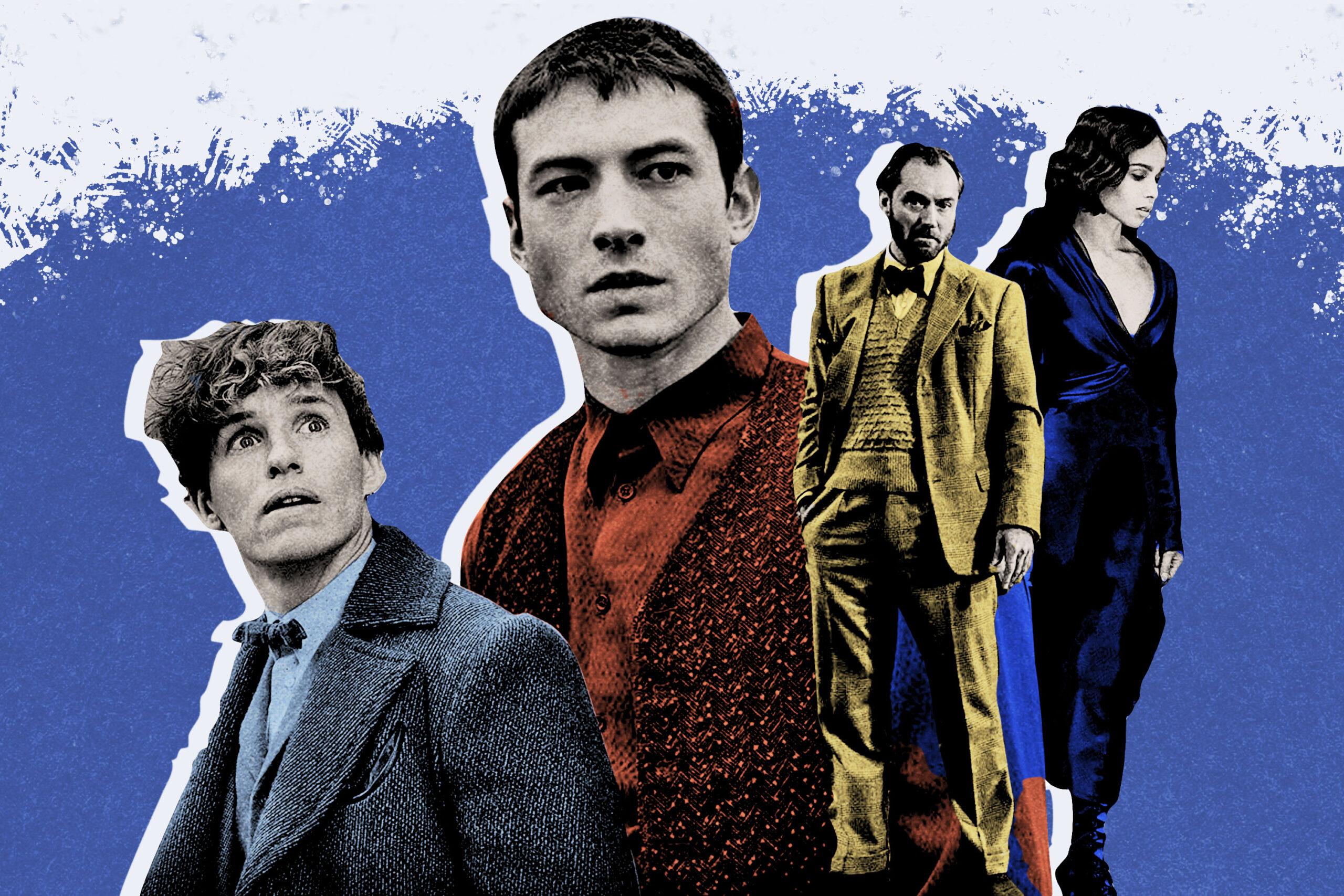

“I don’t do sides,” magizoologist and protagonist Newt Scamander tells his government careerist brother early in Fantastic Beasts: The Crimes of Grindelwald, which arrives in theaters Friday. He’ll soon learn the untenability of this position and the importance of finding his lane—but unfortunately for the viewer, the film doesn’t heed its own advice.
Crimes of Grindelwald tries to do a lot all at once to often disorienting effect, like Hermione taking extra classes but without the aid of a Time-Turner. It’s part mystery, part action romp, part PETA-lite advertisement, part heist caper, part class commentary, part romance, and part seven other things, and instead of blending together, those disparate elements remain separated, in essence divided, leaving a crowded and chaotic movie in their wake.
Yet the second Beasts film is not unique because it’s messy. It’s not unique because it’s inscrutable to much of its audience. And it’s not unique because its pace is as scattered as Newt’s beasts across New York. Those issues have plagued previous Potter movies, on occasion all at the same time. Crimes of Grindelwald is unique because it is the first wizarding tale from J.K. Rowling—who penned the seven Harry Potter books and has written the script for both Beasts movies—that doesn’t work as a self-contained story. It might well end up a satisfying part of a larger whole, but it’s not satisfying in and of itself—and the fact it doesn’t come close suggests a much broader issue than an overstuffed cast or convoluted plot.
A serialized story, broadly speaking, should seek to entertain both in the moment and as a component piece in a larger project. These dual demands can work in complement, but they prove a tricky balancing act for many such efforts. Tilt too far to the short term and each entry seems disconnected and stagnant; tilt too far toward the long term and the resulting story becomes so concerned with setting up its successors that it forgets the audience presumably wants to enjoy it just as earnestly as it wants to enjoy its sequels.
Rowling’s Harry Potter novels were so successful in part because they mastered this balance. As the seven-part book series progressed, each installment contributed to the larger battle between Harry and Voldemort—but still contained its own beginning, middle, and rewarding end. Even the first film in this prequel series, 2016’s Fantastic Beasts and Where to Find Them, which staggered to some extent from its fundamental mismatch between the best parts (the enchanting tour of Newt’s zoo and the animal interactions) and the most important ones for the long game (the dour scenes with Credence), zipped through traditional storytelling beats. It featured an expository period, followed by rising action and a climax that addressed the movie’s main problem and a denouement as sweet as Jacob’s Polish pastries—a classic example of Freytag’s pyramid for dramatic structure.
The sequel, though, largely eschews such norms, and thus flips its predecessor’s charming dynamic. The first Beasts was fun if not essential; the second tries to be so essential to the understanding of the Potterverse that it isn’t much fun at all. Here, the exposition is nearly ever-present, and neither of the primary problems receives much resolution.
Gellert Grindelwald’s rise is the obvious concern, and while it’s not a surprise to see the series’ villain survive to torment our heroes in future installments—especially in this series, which we must assume is leading toward the famed Dumbledore-Grindelwald duel in 1945—this specific ending thus felt flat and inconsequential. In the Potter books, Harry escapes Voldemort several times before the ultimate climax, but he also handles other meaningful challenges along the way; here, all of the various characters’ strands spin so tight around Grindelwald’s web of influence that nothing else breaks through.
Credence’s family background is another motivating factor for the plot, but similar problems sprout from this branch. Given the weight the eventual reveal carries, the relative lack of screentime for the orphaned traveler poses a perplexing puzzle, for one, and it doesn’t come until the film’s final line, allowing no room for fallout. Meanwhile, the answer itself is so confounding that the same question will recur going forward, too. Grindelwald tells Credence that he is Albus Dumbledore’s brother, but the notion is preposterous enough that it might be wrong, which would mean two full movies built toward a lie. Or it’s true, in which case it’s quite possible that the new information we’ll learn about Dumbledore’s past will ruin his apparent maturation and honesty in the original series’ “King’s Cross” chapter—one of the most beloved in the entire canon.
This imbalance makes it difficult to judge this movie on its own merit. Does the ending work? Well, it depends on its ripple effects for the next film and wider Potter lore. Did the maledictus Nagini meet the trailer-born hype? No, but she might in the future. And so on.
To be fair, lots of contemporary storytelling functions in this fashion. As Amanda Hess wrote in The New York Times this week, in this age of sequels and prequels and reboots, “movies do not begin and end so much as they loiter onscreen.” That this description fits Crimes is an indictment of the film’s capacity to captivate, though, and Rowling’s story suffers from another related problem. If the movies maintain their planned every-other-year pattern, we’re still two years away from Beasts 3 and six years away from the series-ending Beasts 5. It’s one thing when a Game of Thrones installment operates chiefly as a bridge from one episode to another and viewers must wait another week for resolution; it’s quite another when that weeklong period swallows an engorgement charm and blooms into years, plural. That’s a long time for curiosity to curdle into exasperation.
For now, at least, curiosity about the Credence reveal is rampant, but it comes amid unique context for a Rowling story. The original seven books each reached a sensible stopping point with the cessation of another school year, and Deathly Hallows: Part 1 aside (after Warner Bros. decided to split the seventh book into two movies), the films all followed the same pattern. The first Beasts also came to a natural resting point. All those stories yielded ample setup for the future, but they also answered many of the questions they put forth.
Now we’ve stumbled upon a cliffhanger just for cliffhanger’s sake, which is new. Snape killing Dumbledore, Voldemort returning to power, Harry learning the prophecy—all of these developments dangled in front of readers in the space between books, but they also benefited from two key differences. First, they were almost as crucial for character growth as they were for the plot, and second, they were the logical results of intricate plotting, whereas this reveal sprung with scant prior hinting. In the core Potter series, Rowling also didn’t venture into an epilogue until the finale, but what else to call the closing scene in Nurmengard, which contained the film’s biggest revelation and an obvious tease for the next installment? It’s half a surprise that a cheeky “To be continued …” graphic didn’t fly on screen with Fawkes at the end.
It might make for an effective marketing tactic for Beasts 3 as viewers scramble to learn what happens next (even as Crimes is tracking for the lowest domestic debut weekend for any film in the Potterverse), but that doesn’t make it an effective storytelling technique. Compelling fantasy can’t subsist only on the theories it inspires—howdy, Westworld—because the journey to the end should be just as entertaining as, if not more so than, the final reveal. In Crimes, though, the journey is rushed. Deathly Hallows sees Harry, Hermione, and Ron prepare for a full month for their infiltration of the British Ministry of Magic; in the new movie, Newt and Tina trade five lines in an alleyway as the entirety of their planning before sneaking into the French Ministry.
Charitably, we might suggest that this set of related problems stems from the cinematic medium, which is still new to Rowling. She writes novels, and she writes them long—each of the last four Potter books tallied at least 652 pages, against which two hours and 14 minutes’ worth of screenplay is scant time for character development or a natural flow of time and events. Yet this plot likely would have seemed shockingly dependent on the other Beasts titles even in book form, and that’s not how she chose to tell this particular story—nor is it how she’s choosing to tell the next three Beasts installments, either.
Crimes is ultimately wholly beholden to what came before and, even more, what will come after. Perhaps it will arouse fonder reactions after everyone has also seen 2020’s Fantastic Beasts 3: We Left a Cliffhanger So You’d Come Back and 2022’s Fantastic Beasts 4: Actually, There Are No Beasts, It’s a Dumbledore Series Now and 2024’s Fantastic Beasts 5: April Duel’s Day. But to take that wager in 2018 is so risky that even Ludo Bagman might think twice before accepting—and Crimes didn’t inspire much confidence that we won’t feel the exact same way about its successor. What’s to stop Warner Bros. from releasing another transitional story in two years, as the interconnected chain of the series continues but each individual link falters under critical inspection?
It’s a worrisome development for a creator who hadn’t erred in her story construction before—either within each discrete tale or within the larger collections they create—and for a fictional universe full of complex characters and rich settings and literally magical customs. So much happens in Crimes, the breakneck plot suggesting a stringent push for forward momentum, that the movie feels paradoxically stuck in place. There might be enchantments to come in the Beasts franchise; there probably are, given Rowling’s gifts as a creator of fiction. But that doesn’t mean there wasn’t a story worth fully exploring in the meantime.

